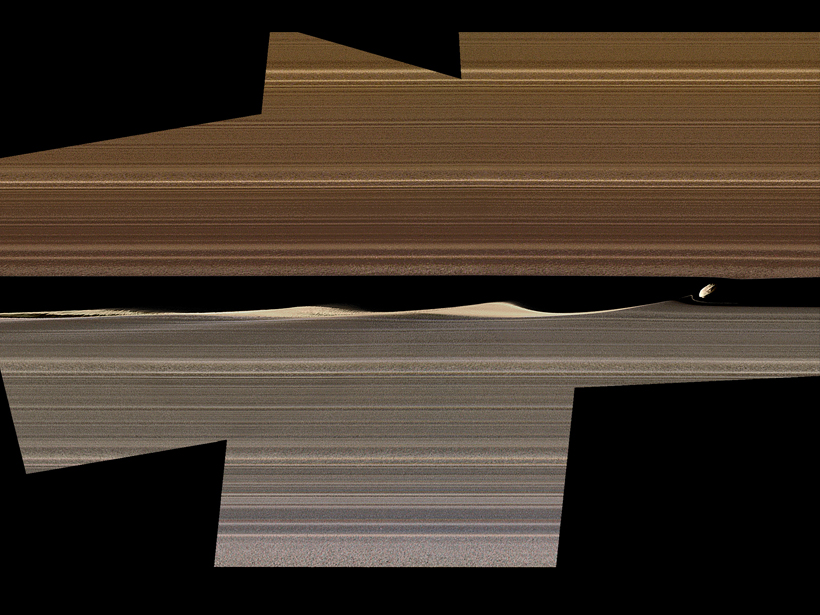After more than a decade observing Saturn, Cassini completed its mission in style—a grand finale sent the spacecraft on almost 2 dozen dives between the planet and the rings before it took its final descent into Saturn’s atmosphere.
During these ring-grazing trips during summer 2017, Cassini collected high spatial resolution images and spectral and temperature scans of the rings. Years after its crash, researchers are still working with the piles of data Cassini collected, making new discoveries about the ringed planet.
In a new paper in Science, researchers dove into these high-resolution data, and their synthesis revealed new features inside the rings that hadn’t been seen before. They found sculpted areas within the rings—including banded textures and disturbances from embedded bodies—that can be used to help theorists narrow in on how Saturn and its rings may have formed.
Ring Disruptions
“We found a number of things that are new—a number of structures that we’d never been close enough to see before.”
During the grand finale, Cassini took high-resolution images of all the rings, from the ring closest to the planet (ring D) to the F ring, one of the most distant. The images are the highest-fidelity images ever to be taken of the rings, and they revealed some surprises to the research team.
“We found a number of things that are new—a number of structures that we’d never been close enough to see before,” says Matthew Tiscareno, a senior research scientist at the SETI Institute in Mountain View, Calif., and lead author of the paper.
The team explored disturbances within the rings related to moons or smaller moonlike debris embedded in the rings. The moon Daphnis, for example, leaves a wide trail of disruption in its wake, including a wide gap in the ring and trailing waves of debris.
These waves, Tiscareno explains, are created by the rings moving at different speeds: The rings orbiting closer to Saturn move at a faster speed than those farther from the planet. This process creates a shear flow, and “on the outward edge, the ring part, the ring material is falling behind Daphnis and its orbit,” he says.

But it’s not just big moons like Daphnis that disrupt the rings. Smaller objects are trying their best to create ring gaps as well, but with less success. “These are objects that are 10 times smaller, which means they’re a thousand times less massive,” says Tiscareno.
Instead of forming a gap, Tiscareno says these objects form a propeller-shaped disturbance.
The researchers knew the propellers existed, so they asked Cassini to perform some targeted flybys to get a closer look.
“The details of that [propeller] structure [are] telling us exactly how big the moons are at the center of the propeller…about a kilometer across,” says Tiscareno, adding that at that size, it’s not possible to see the actual moon with these image resolutions.
Ring Textures
Cassini’s instruments also revealed new details on textures within the rings. “We knew that there were textures before, but we had not seen them as comprehensively,” says Tiscareno. The team noted that the ring textures ranged from strawlike clumps to feathery regions, with sharp edges on their borders.
One idea for the different textures within the rings is a changing particle composition, says Douglas Hamilton, an astronomer at the University of Maryland who was not involved with the paper. For example, one part of the ring could be more silicate rich, whereas another area has more ice. But Hamilton says the researchers “make a good case” for these textures being caused by something other than composition.
The team inferred that the sharp borders along the ring textures were not due to a composition change, says Tiscareno, but instead result from the physical properties of the ring particles.
One physical property might be the roughness of ring particles. Tiscareno explains: Is a ring particle more like a billiard ball or more like a snowball? Roughness can affect not only the reflection of light but also how particles interact with each other. “Do they bounce off of each other, like billiard balls do?” he asks. “Or are they kind of sticky, like a snowball would be?”
Forming a Ring
“Rings are our only natural laboratory to understand disk processes more generally—and that goes to understanding baby solar systems.”
Getting close-up data from Cassini gives researchers information that reaches beyond our nearby ringed planet.
“Rings are our only natural laboratory to understand disk processes more generally,” says Tiscareno. “And that goes to understanding baby solar systems, which are disk systems where you have massive objects that are embedded in the disk.”
“We’re seeing massive objects embedded in the rings, and we’re seeing the disk itself doing things that we didn’t expect,” he adds.
Hamilton says that papers like this help uncover how features like propellers might form. “The theory is our imagination,” Hamilton says. Work like this paper, he adds, allows theoretical researchers to be able to test their models on Saturn’s rings against observed data.
“[These data are going] to be the basis for 10 years of effort by the entire field in trying to figure out how to make all this [propellers, textures] happen,” says Hamilton.
—Sarah Derouin (@Sarah_Derouin), Freelance Journalist
18 July 2019: This article has been updated to correct the identification of rings in Saturn’s ring system and the shear flow associated with waves in the rings.
Citation:
Derouin, S. (2019), The Cassini mission may be over, but new discoveries abound , Eos, 100, https://doi.org/10.1029/2019EO128651. Published on 17 July 2019.
Text © 2019. The authors. CC BY-NC-ND 3.0
Except where otherwise noted, images are subject to copyright. Any reuse without express permission from the copyright owner is prohibited.

